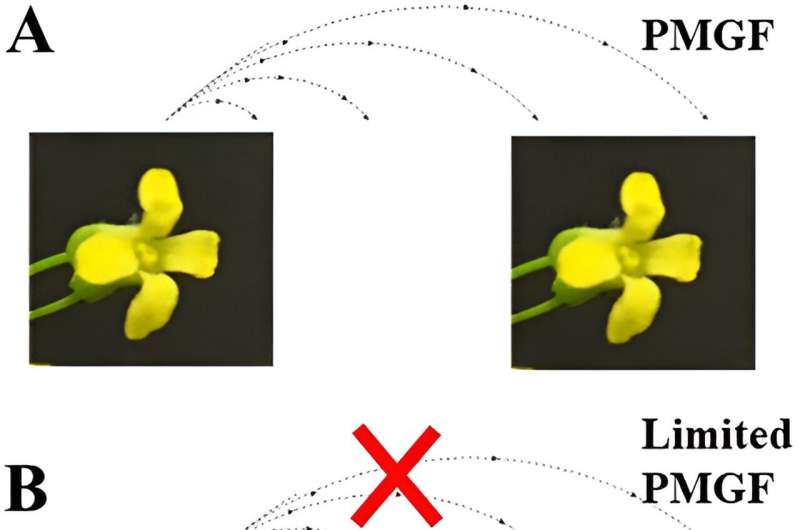This article has been reviewed according to Science X's editorial process and policies. Editors have highlighted the following attributes while ensuring the content's credibility:
fact-checked
peer-reviewed publication
trusted source
proofread
Preventing pollen-mediated gene flow from transgenic camelina using engineered cleistogamy

Camelina sativa (L.) Crantz. is native to Europe and Central Asia, and cultivated as an oilseed crop in Europe, Asia, and North America. It is not only rich in nutrients, such as a high content of unsaturated fatty acids, but it also possesses valuable agronomic traits.
Genetic engineering has enhanced camelina's yield, fatty acid composition, and drought resistance, among other traits. However, the inclusion of transgenic camelina into the agricultural landscape carries high risks related to the introgression of transgenes into related agricultural and wild relatives.
Existing research shows substantial pollen-mediated gene flow (PMGF) from transgenic camelina to non-transgenic camelina and the wild relatives, raising concerns. Thus, bioconfinement strategies, such as cleistogamy (self-pollination without petal opening), are under exploration to prevent unintended PMGF and ensure sustainable deployment of transgenic camelina.
Horticulture Research published a perspective entitled "Engineered Cleistogamy in Camelina sativa for Bioconfinement."
In this study, researchers aimed to assess the impact of overexpressing the PpJAZ1 gene on flower petal opening in camelina. For this, the PpJAZ1 gene was stably transformed into camelina using the floral dip method.
Out of 83 independent T1 overexpression lines developed, 17 showed evidence of a single T-DNA insertion. When analyzing the phenotypic differences between transgenic and non-transgenic camelina, no differences were observed before flowering. However, as the plants began to flower, notable differences in flower petal opening were evident.
Camelina flowers have four developmental stages, i.e. the flower bud (day 0), anthesis (day 1), post-anthesis (day 2), and fruit formation (day 3) stages. Researchers observed phenotypic difference between the overexpression lines and the non-transgenic camelina came from the degrees of cleistogamy in the overexpression lines at day 1 only.
PCR amplification confirmed the integration of the PpJAZ1 gene into all nine chosen overexpression lines. Real-time RT-PCR revealed up to 20-fold overexpression of PpJAZ1 in the leaves of these lines, but the levels of gene expression were not tightly correlated with the cleistogamy levels.
Further evaluation of the effect of PpJAZ1 overexpression on seed yield, they found that fruit abortion was only observed on the main branches of the transgenic lines and was apparently correlated with the levels of cleistogamy. When compared to the non-transgenic plants, up to 20–50% decrease in silicle number per plant and seed number per plant was identified in some transgenic lines. However, no significant differences were found in terms of seed weight.
The study also explored the effect of PpJAZ1 overexpression on pollen viability. Pollen germination rates revealed that the transgenic plants had reduced pollen viability on days 2 and 3 when flower finished anthesis and petals started to fall off. Lastly, to determine the effect of the overexpressed PpJAZ1 on PMGF under open-field conditions, two field trials were conducted with PpJAZ1 overexpression line #21 and transgenic camelina line overexpressing the GUSPlus reporter gene (control line).
While there were variations in hybrid ratios based on distance and wind direction, the PpJAZ1 overexpression line showed a significantly lower hybrid ratio compared to the GUSPlus control line. Therefore, the overexpressed PpJAZ1 dramatically restricted PMGF under the field conditions.
In conclusion, this study shows that overexpressed PpJAZ1 dramatically inhibited PMGF from transgenic camelina to non-transgenic camelina under the field conditions, and could be used for bioconfinement in other dicot species, ensuring environmentally responsible deployment of transgenic plants.
More information: Debao Huang et al, Engineered Cleistogamy in Camelina sativa for bioconfinement, Horticulture Research (2022). DOI: 10.1093/hr/uhac280
Journal information: Horticulture Research
Provided by NanJing Agricultural University



















